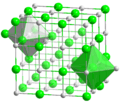Chloride facts for kids
Chloride is a special kind of ion that comes from the element chlorine. Think of an ion as an atom or molecule that has an electric charge because it has gained or lost one or more electrons. When a chlorine atom gains an electron, it becomes a negatively charged ion called chloride. This process is called reduction.
Chloride is super important for all living things, including you! It's a key part of sodium chloride, which is the common table salt we use every day.
Contents
What is Chloride?
Chloride is essentially a chlorine atom that has picked up an extra electron. Because electrons have a negative charge, adding one makes the chlorine atom become a negatively charged ion. This negative charge is what makes it a "chloride" ion. It's like a tiny magnet with a negative end, ready to connect with positively charged particles.
How Chloride Forms
Chlorine is a gas that you might know from swimming pools. But when a chlorine atom meets something that can give it an electron, it happily takes it. This act of gaining an electron is called "reduction." Once it gains that electron, it changes from a neutral chlorine atom into a negatively charged chloride ion. This ion is much more stable and often forms bonds with other elements.
Why Chloride is Important
Chloride plays many vital roles in your body. It helps keep the right balance of fluids inside and outside your cells. This balance is super important for your cells to work correctly.
- Digestion: Chloride is a key part of the stomach acid (hydrochloric acid) that helps break down food. Without enough chloride, your body would struggle to digest meals properly.
- Nerve signals: It helps your nerves send electrical signals throughout your body, allowing your brain to communicate with your muscles and organs.
- Blood pressure: Chloride also helps regulate your blood pressure.
Where Do We Find Chloride?
The most common place to find chloride is in sodium chloride, which is the salt you sprinkle on your food. This salt is made of sodium ions (positive) and chloride ions (negative) linked together.
- Food: Besides table salt, chloride is naturally present in many foods, especially processed foods, because salt is often added for flavor and preservation.
- Oceans: Seawater is full of chloride! That's why the ocean tastes salty. It's one of the most abundant ions in the ocean.
Related pages
Images for kids
See also
 In Spanish: Cloruro para niños
In Spanish: Cloruro para niños


